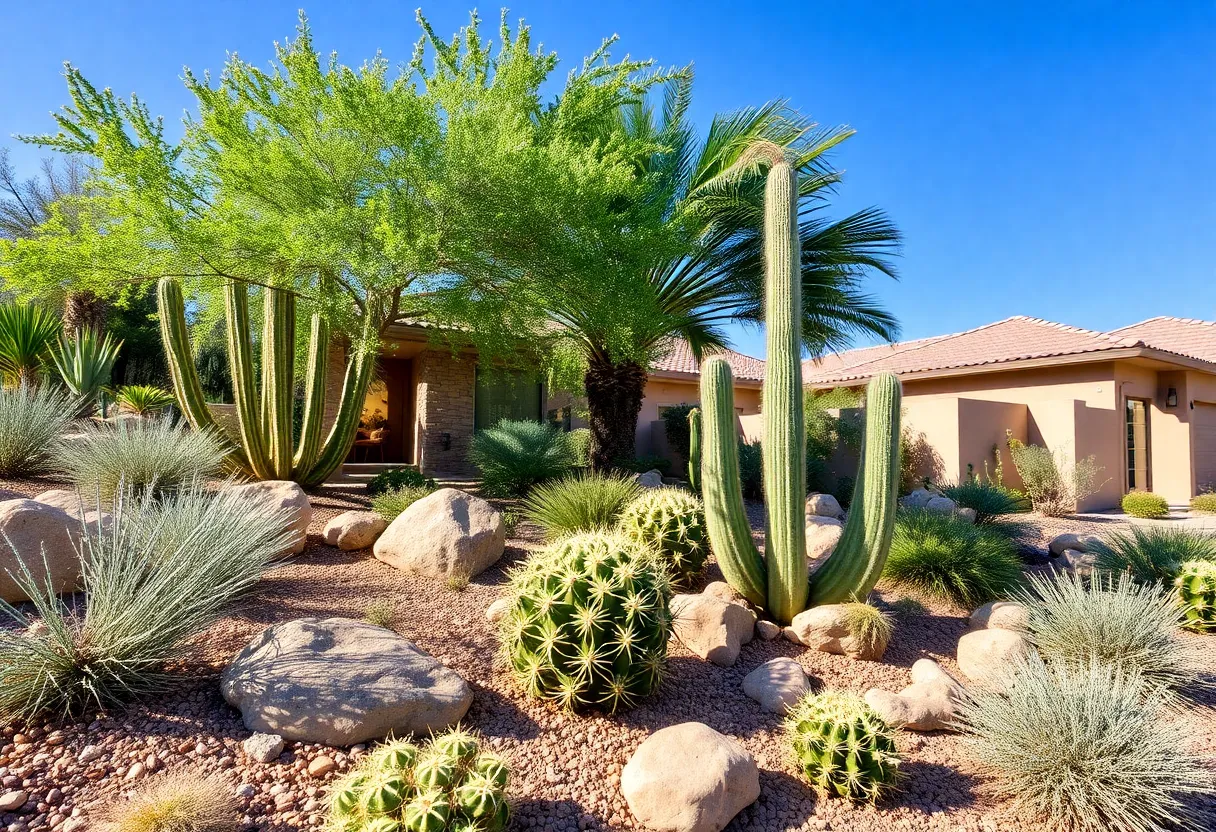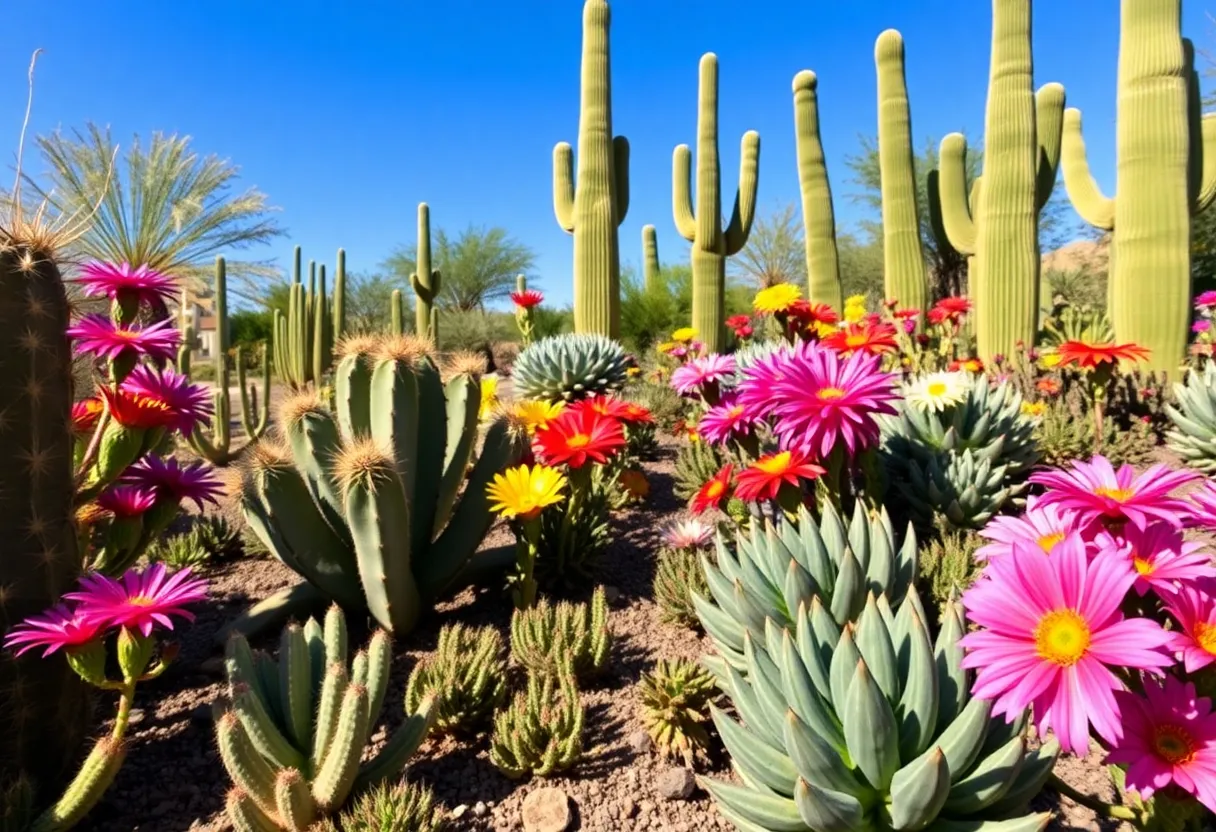Creating a Stunning Xeriscape Garden in Phoenix: A Guide to Sustainable Landscaping
Introduction
Designing a xeriscape garden in Phoenix offers a strategic way to blend aesthetic appeal with environmental responsibility. Arid regions like Phoenix face water scarcity challenges, making water conservation a top priority for homeowners and landscapers. Implementing xeriscaping principles enhances the beauty of your property while significantly reducing water consumption, supporting local ecosystems, and lowering maintenance efforts. This comprehensive guide explores how to create a stunning xeriscape in Phoenix by focusing on plant selection, design practices, and sustainable irrigation techniques.
Understanding Xeriscaping
Definition and Origins
The term “xeriscape” combines the Greek root “xeros”, meaning dry, with the suffix “scape”, referring to landscape design. It emphasizes landscaping practices that significantly reduce or eliminate the need for supplemental irrigation. Originally developed for arid climates, xeriscapes prioritize drought-tolerant plants, efficient water use, and sustainable garden management.
Core Principles of Xeriscaping
- Planning and Design: Designing landscapes based on native plants, microclimates, and site conditions.
- Soil Improvement: Amending soil to optimize water retention or drainage as needed.
- Efficient Irrigation: Using drip systems and scheduling to minimize water loss.
- Appropriate Plant Selection: Choosing native or drought-tolerant species suited for the climate.
- Mulching: Covering soil to retain moisture, suppress weeds, and stabilize soil temperature.
- Maintenance: Regular pruning, weeding, and seasonal adjustments to sustain the landscape.
Benefits of Xeriscaping in Phoenix
Water Conservation
Traditional landscaping often relies on high-water-use grasses and lush plantings, which are incompatible with Phoenix’s dry conditions. Xeriscaping can reduce water usage by up to 60%, efficiently utilizing limited water resources and lowering utility bills.
Low Maintenance
By selecting native, drought-tolerant plants, homeowners reduce the need for frequent watering, fertilizing, and pest control. This results in a garden requiring less intervention and upkeep.
Visual Appeal and Aesthetic Diversity
A well-designed xeriscape highlights the natural beauty of desert flora. Incorporating a variety of textures, colors, and architectural plants creates an eye-catching landscape that reflects the local environment.
Environmental and Ecological Impact
Using native plants supports local wildlife such as birds, bees, and butterflies. It also promotes *biodiversity* and reduces the ecological footprint of landscaping activities.
Steps to Create a Stunning Xeriscape Garden in Phoenix
1. Conduct a Landscape Assessment
Begin by analyzing your current landscape to identify high water-consuming zones. Use this information to prioritize areas for transformation. Assess soil quality, sun exposure, and existing plant health.
2. Design with Purpose
Develop a detailed plan that groups plants based on their water requirements — hydrozones. Incorporate non-living elements like rocks, mulch, pathways, and ornamental features to enhance visual interest and functionality.
3. Select Suitable Plants
Prioritize plants native to the Sonoran Desert or proven drought-tolerant species adaptable to Phoenix’s climate. These typically include:
- Trees and Shrubs: Palo Verde, Desert Willow, Texas Sage.
- Succulents and Cacti: Agave, Prickly Pear, Ocotillo.
- Groundcovers and Grasses: Buffalo Grass, Blue Grama, Bermudagrass.
- Flowering Plants: Desert Marigold, Mexican Poppy, Penstemon.
4. Implement Efficient Irrigation Systems
Use drip irrigation to deliver water directly to roots, reducing evaporation. Schedule watering based on seasonal needs, optimizing frequency and duration to match plant moisture requirements.
5. Improve Soil Quality
Amend native soil with organic matter such as compost to enhance water retention, aeration, and fertility. Conduct soil testing to validate pH levels and nutrient content for optimal plant growth.
6. Apply Mulch Effectively
Use materials like organic wood chips or decorative gravel to cover soil. Mulching conserves moisture, keeps plants cooler, and suppresses weeds, limiting water use further.
7. Ongoing Maintenance
Regularly prune to maintain plant health and shape. Remove invasive weeds promptly. Adjust watering schedules for seasonal changes and replace or add mulch periodically.
Design Tips for a Visually Striking Xeriscape
Combine height variation by incorporating mature trees with groundcovers. Use color contrasts with flowering plants and succulents. Emphasize *texture differences* to add visual interest. Incorporate natural stones or decorative gravel for both functional and aesthetic purposes.
Utilize Local Resources for Inspiration and Education
Many local demonstration gardens showcase successful xeriscape designs and provide educational information. These gardens highlight native plants, sustainable practices, and landscape ideas tailored to Phoenix’s climate—valuable references for homeowners planning their own xeriscape projects.
Conclusion
Creating a stunning xeriscape garden in Phoenix is an investment in both environmental sustainability and property value. By focusing on native drought-tolerant plants, efficient irrigation, and thoughtful design, homeowners can achieve a beautiful, low-maintenance landscape that conserves valuable water resources. These practices support a healthier local ecosystem and provide long-term benefits, making xeriscaping an essential strategy in arid urban environments.
Frequently Asked Questions
What is xeriscaping and why is it suitable for Phoenix?
Xeriscaping is a landscaping technique that reduces or eliminates the need for supplemental water by utilizing drought-tolerant plants, efficient irrigation, and low-maintenance design. It is ideal for Phoenix due to its arid climate and water scarcity challenges.
Which plants are best for xeriscaping in Phoenix?
Suitable plants include native species like Palo Verde, Desert Willow, and Mexican Poppy, as well as succulents such as Agave and Prickly Pear. Groundcovers like Buffalo Grass and Blue Gama are also highly recommended.
How can I improve water efficiency in my xeriscape garden?
Install drip irrigation systems, use mulches to retain moisture, group plants by water needs, and adjust watering schedules seasonally to ensure efficient water use and minimize waste.
Do xeriscape gardens require less maintenance?
Yes. Native, drought-tolerant plants generally need less watering, fertilizing, and pest control, resulting in a garden that demands less routine upkeep.
Key Features of a Successful Xeriscape Garden in Phoenix
| Feature | Description | Benefit |
|---|---|---|
| Native Plant Selection | Using indigenous drought-tolerant plants suited for Phoenix’s environment. | Maximizes survival rates while conserving water. |
| Efficient Irrigation | Employing drip systems and smart scheduling to target plant roots. | Reduces water waste and ensures proper hydration. |
| Mulching | Applying organic or inorganic mulch around plants and beds. | Maintains soil moisture, inhibits weeds, and stabilizes temperature. |
| Design and Grouping | Arranging plants by water needs and aesthetic balance. | Creates a harmonious visual while optimizing resource use. |
| Scenic and Functional Elements | Incorporating rocks, pathways, and native landscape features. | Enhances visual interest and garden usability. |
Author: STAFF HERE PHOENIX WRITER
The PHOENIX STAFF WRITER represents the experienced team at HEREPhoenix.com, your go-to source for actionable local news and information in Phoenix, Maricopa County, and beyond. Specializing in "news you can use," we cover essential topics like product reviews for personal and business needs, local business directories, politics, real estate trends, neighborhood insights, and state news affecting the area—with deep expertise drawn from years of dedicated reporting and strong community input, including local press releases and business updates. We deliver top reporting on high-value events such as the Waste Management Phoenix Open, Cactus League Spring Training, and Arizona State Fair. Our coverage extends to key organizations like the Greater Phoenix Chamber of Commerce and Visit Phoenix, plus leading businesses in technology and healthcare that power the local economy such as Intel and Banner Health. As part of the broader HERE network, including HERETucson.com, we provide comprehensive, credible insights into Arizona's dynamic landscape.





